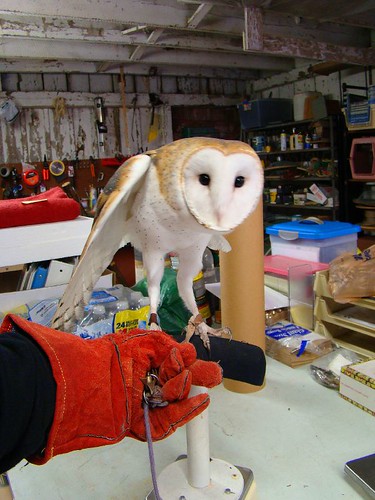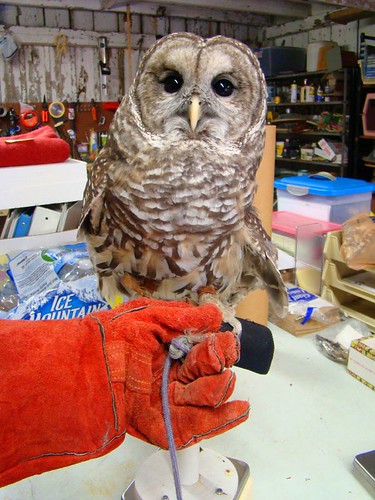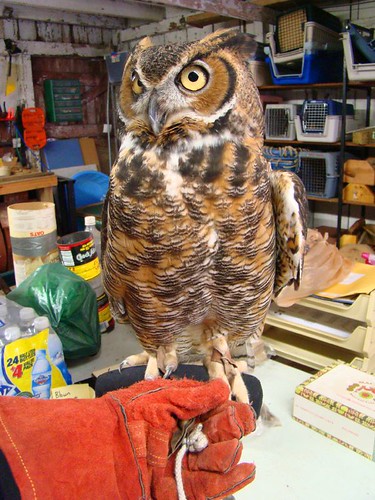One of my duties as education director is to monitor our birds for signs of poor health:
Talon/beak issues: Captive birds have a limited diet, and talon and beak deformities can be a sign of liver trouble.
Swellings: Example...Lucy's tumor.
Breathing problems: Raspy, labored breathing could be symptoms of aspergillus, a fungal infection, or could be a sign of aspiration.
Bad breath: Really. It's true. Bad breath can be a sign of a crop that cannot completely empty itself. Lucy's breath, though, smells like Skyline Chili. Yet another reason I love her so much
Checking mutes (That's raptor poop, for you non-aficionados):
A healthy bird will shoot out nice, well-defined poop that is a white puddle of liquid (urate) a little pile of fecal matter (the consistency of toothpaste) in the middle and a clear liquid that flushes it from their system (the "pee"). Green or red liquid or solid is to be reported.
Weight fluctuations:
Birds weigh different amounts depending on the time of year or whether they have a full or empty crop. A full crop (say, 20 grams worth of mouse) can dramatically affect the weight of a 150 gram screech owl. Our birds are weighed periodically to track any drastic changes.
The other day, it was a parade of owls on the scale.
The scale is a simple table scale, like one you would weigh mail with, and a modified perch on top:

Storm, our Barn Owl, weighed in at 460 grams. (If you forget how to translate grams into pounds, 453.6 grams equals 1 pound) His attitude says that he thinks he tops off about 275 pounds.
I lift the swivel ( the metal doo-hickey that we use to tether the birds to our hand) so that it is not being added to the weight.

Priscilla our Barred Owl weighed in slightly more that Storm, just about 1 1/4 pounds.
Barred owls look huge, but in reality they are fluffy feather pillows with a stick in the middle.

Big Man Sylvester topped the scales at 1500 grams, or 3.3 pounds. And unlike Barred Owls, Great Horned Owls are all muscle. They are feathered bricks.
Lucy our Peregrine Falcon, as it turns out, has a sense of humor.
Saturday, as I was doing my weekly visual check of all the program birds, I stopped in Lucy's mew. I asked her to step up and checked her wing. All was well there.
I let her step back onto her rock perch, and she leaned forward, turning her head back and forth. I usually hand feed her when I am there, so she was waiting for food to appear in my hand. I picked up a mouse from her feeding block, and offered it to her.
She grabbed it willingly...then leaned forward and let it drop to the ground at my feet. I bent over and picked it up. Offered it to her again, and the same thing happened. I watched her as I did it a third and fourth time, and she was practically leaning into my face, watching me every time I bent to pick up the mouse.
She was playing.

9 comments:
(smiling for you)
Susan, real fascinating stuff. Had no idea owls weighed as little as they do. Lucy sounds like a real character, I would fall in love with her too.
I'll bet you were just thrilled!
What a fun informative post...I love your descriptions of each of these raptors.
And the photos--sigh. A good way to start the day.
I've never seen any of our birds do anything remotely like that...except for Earl. She loves to play with all of the TOYS we have hung in her mew.
This was an absolutely fascinating & informative post! The practical issues of captive birds! Thanks
We currently have an Osprey to rehab at RROKI in Louisville. A very nice bird, but he only eats fish that wiggles, so we have to hand feed him every day. If you stick a piece of fish in his mouth, he'll swallow it. I don't know what will happen to him eventually.
I think Lucy is stellar!
A peregrine falcon with a sense of humor? That's so cool Susan!
Post a Comment